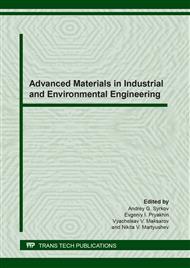[1]
O. A. Makarenko, Resource of Steel Tanks, Nedra, St. Petersburg, (2008).
Google Scholar
[2]
Dakai Bian, Interlaminar Toughening of Fiber Reinforced Polymers (Submitted in partial fulfillment of the requirement), 2018, p.135.
Google Scholar
[3]
B. Naughton, Composite Materials: The Use of Composite Materials in Technology, Engineering, Moscow, (1978).
Google Scholar
[4]
A. S. Kolobkov, S. S. Malahowski, Self-healing composite materials, Proceedings of VIAM 1 (2019) 47-54.
Google Scholar
[5]
C.V. Kondrashov, L. V. Solovyanchik, A. A. Melnikov, T. P. Dyachkova, V. M. Buznik, Hybrid composite fiberglass for shielding electromagnetic radiation of microwave frequencies, Proceedings of VIAM 7 (2018) 78-87.
Google Scholar
[6]
A. A. Pykhtin, I. D. Simonov-Emelyanov, Effect of nano- and ultrafine particles of silicon dioxide (SiO2) on the toughness of epoxy polymers, Proceedings of VIAM 6 (2019) 3-12.
Google Scholar
[7]
J.L. Tsai, B.H. Huang, Y.L. Cheng, Enhancing Fracture Toughness of Glass/Epoxy Composites by Using Rubber Particles Together with Silica, (2009).
DOI: 10.1177/0021998309345299
Google Scholar
[8]
S. Deng, K. Friedrich, Fracture behaviors of epoxy nanocomposites with nano-silica at low and elevated temperatures, Journal of Materials Science 42 (2007) 2766-2774.
DOI: 10.1007/s10853-006-1420-x
Google Scholar
[9]
V.A. Gafarova, Materials and Method for Filling Cracks in Oil and Gas Equipment during the Overhaul Period of Operation, candidate dissertation, (2019).
Google Scholar
[10]
E.N. Kablov, L.V. Chursova, A. N. Babin, R.R. Mukhametov, N.N. Panin, Developments by FSUE VIAM in the field of melt binders for polymer composite materials, Polymer materials and technologies 2 (2016) 37-42.
DOI: 10.32864/polymmattech-2016-2-2-37-42
Google Scholar
[11]
V.G. Zheleznyak, L. V. Chursova, M. M. Grigoryev, E. I. Kosarina, Study of increasing shock resistance of polyisocyanurate with a modifier based on linear heat-resistant polymers, Aviation materials and technologies 2 (2013) 26-28.
Google Scholar
[12]
E.N. Kablov, S.V. Kondrashov, G. Yu. Yurkov, Prospects for the use of carbon-containing nanoparticles in binders for polymer composite materials, Russian nanotechnology 3-4 (2013) 24-42.
Google Scholar
[13]
R.V. Akatenkov, S.V. Kondrashov, A.S. Fokin, P.S. Marakhovsky, Features of the formation of polymer networks during the curing of epoxy oligomers with functionalized nanotubes, Aviation materials and technologies 2 (2011) 31-37.
Google Scholar
[14]
N. S. Perov, Design of polymer materials on molecular principles. I. The creation of polymer materials with additional mechanisms of dissipation of mechanical energy at low temperatures, Aviation materials and technologies 3 (2017) 50-55.
DOI: 10.18577/2071-9140-2017-0-3-50-55
Google Scholar
[15]
R. Das, C. Melchior, K. M. Karumbaiah, Self-healing composites for aerospace applications, Advanced Composite Materials for Aerospace Engineering (2016) 333-364.
DOI: 10.1016/b978-0-08-100037-3.00011-0
Google Scholar
[16]
E. N. Kablov, Innovative developments of FSUE VIAM" SSC RF on the implementation of "Strategic directions for the development of materials and technologies for their processing for the period until 2030,, Aviation materials and technologies 1 (2015) 3-33.
DOI: 10.18577/2071-9140-2015-0-1-3-33
Google Scholar
[17]
R. Massart, Preparation of aqueous magnetic liquids in alkaline and acidic media, IEEE Trans. Magn. 2 (1981) 1247-1248.
DOI: 10.1109/tmag.1981.1061188
Google Scholar
[18]
S.P. Gubin, I.D. Kosobudsky, Metal clusters in polymer matrices, Russian Chemical Reviews 52 (1983) 1350-1364.
Google Scholar
[19]
G.L. Rochfort, R. D. Rieke, Inorg. Chem. 25 (1986) 348-355.
Google Scholar
[20]
D.A. Baranov, S.P. Gubin, Magnetic nanoparticles: achievements and problems of chemical synthesis, Radio Electronics Nanosystems. Information Technology 1 (2009) 129-147.
Google Scholar


